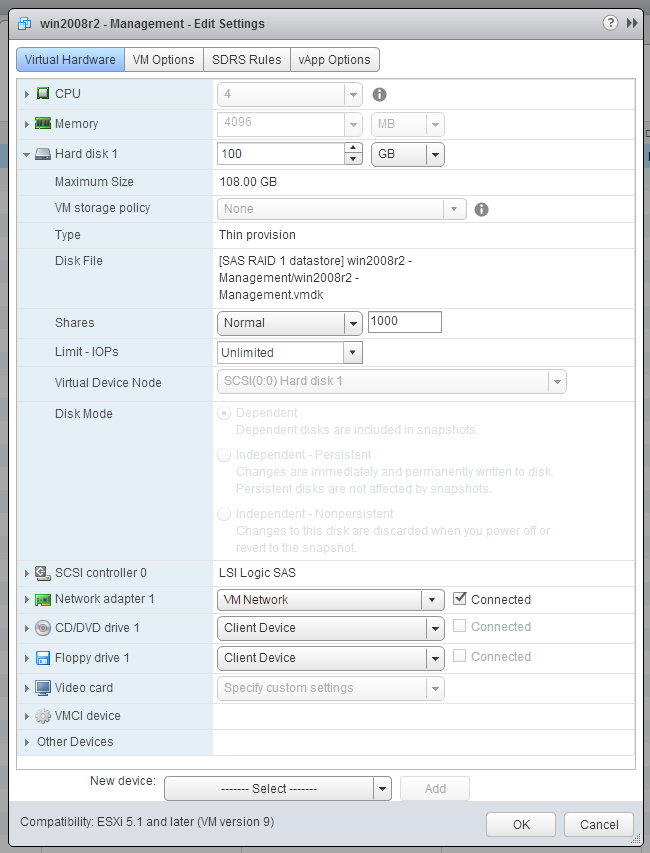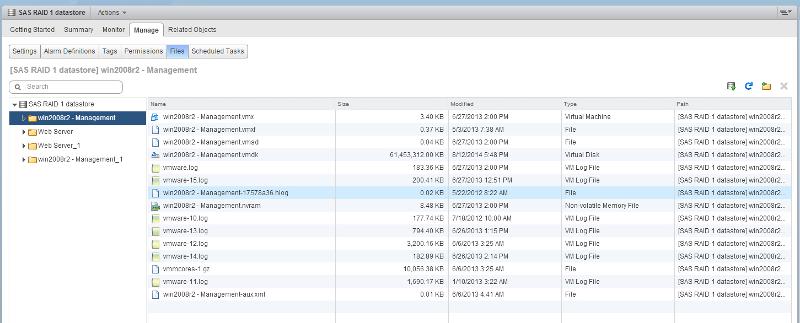How can I combine a VMware VM that has files in two folders?
As you can see, I have a VM with only one Disk...

At some point I think the VM disappeared in vCenter and I added a new VM using the exact same options as before and used the same disk. This created a new folder of files. Here's the two folders...


If you look at timestamps, it appears that things are being referenced in both folders although I don't know how or why. What do I need to do to safely combine these folders? This is my vCenter VM for reference.

At some point I think the VM disappeared in vCenter and I added a new VM using the exact same options as before and used the same disk. This created a new folder of files. Here's the two folders...


If you look at timestamps, it appears that things are being referenced in both folders although I don't know how or why. What do I need to do to safely combine these folders? This is my vCenter VM for reference.
ASKER
No I don't believe I had storage vMotion. Here's what I am running:
Two datastores on this physical ESXi machine
Running VMware vSphere Essentials Kit - Details at bott of this page
.
ASKER CERTIFIED SOLUTION
membership
This solution is only available to members.
To access this solution, you must be a member of Experts Exchange.
ASKER
Wow... sounds pretty easy, thanks. I will give this a whirl after work.
ASKER
Everything went as planned up to step 6. Since the VM I was consolidating was my vCenter VM I had to VMware vSphere Client to copy the VMDK file to the new datastore where I had created the new VM after powering vCenter down. I used vSphere Client to add the disk to the new VM and then fired up the new vCenter. The new recreated/copied VSphere Web Client shows absolutely no resources (VMs, datastores, etc). I'm guessing that's because my changes were made in ESXi but not in the actual vCenter VM... so what can't I do to fix that?
This is normal that you would have to create the VM, directly on ESXi.
After starting vCenter Server, vCenter Server should find the new VM.
After starting vCenter Server, vCenter Server should find the new VM.
ASKER
I understand that but this case seems to be different when the unrecognized VM is vCenter itself. Even though it starts up and I log in, it doesn't even recognizing that it itself exists and I think that is why I can't see a single other VM, host, data enter, data store, network, or any resource from the vSphere Web Client though I can when connecting direct to the ESXi host. Maybe I have to do a manual database update of the vCenter VM ID or something??? I'm not that experienced with VMware.
You don't update the vCenter Database manually.
vCenter Server should discover all VM server automatically.
If you connect to vCenter Server via the vSphere Client, is it different?.
vCenter Server should discover all VM server automatically.
If you connect to vCenter Server via the vSphere Client, is it different?.
SOLUTION
membership
This solution is only available to members.
To access this solution, you must be a member of Experts Exchange.
No VMware Tools installed a VMware VM, you bad boy!
This is not a new vCenter VM, it's the same, just "merged in a folder!"
Weird, never seen it!
As for the solution, it is what it is!
It does not affect the running VM resources!
This is not a new vCenter VM, it's the same, just "merged in a folder!"
Weird, never seen it!
As for the solution, it is what it is!
It does not affect the running VM resources!
ASKER
Gulp... thanks for being gracious with me :) I reaaaaally appreciated your first outline above though and that's why I pay to be here on Experts Exchange. God bless!
and to you, see you soon!
Thanks for your kind words, and that's why I volunteer as an Expert for EE!
Méiyou wenti
(No problems in Chinese!)
Andy
Thanks for your kind words, and that's why I volunteer as an Expert for EE!
Méiyou wenti
(No problems in Chinese!)
Andy
ASKER
Yes, I've seen your name at the top of the lists here before so was honored to get 10 seconds of your time. I'm a web developer so don't have time to know everything there is to know about things like VMware though I still enjoy it.
ASKER
Hancock gave the solution but there was a hangup that wouldn't allow me to complete his solution. I believe I found the last remaining piece to his solution in my particular case.
This can allow you to migrate your VM to another datastore, and it will migrate all the files into the same VM folder.
otherwise if you have no Storage vMotion, you will have to manually reconstruct your VM, and move files.
(and the VM will need to be off to do this)